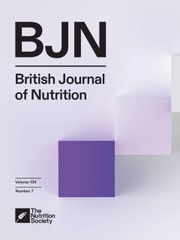Article contents
The efficiency of energy utilization in growing cattle consuming fresh perennial ryegrass (Lolium perenne cv. Melle) or white clover (Trifolium repens cv. Blanca)
Published online by Cambridge University Press: 09 March 2007
Abstract
1. Twenty Friesian steers (225 kg live weight) were fed on mid- (M) (June-July) and late- (L) (August- September) season crops of either fresh perennial ryegrass (Loliumperenne cv. Melle) (G) or white clover (Trifolium repens cv. Blanca) (C). Each of the forage diets was offered at three restricted planes of nutrition above main- tenance to compare the effect of forage species on the efficiency of energy utilization. All diets were harvested daily from swards of regrowth forage of intended equivalent digestibility.
2. Faecal and urine excretions were measured for 7 and 5 d respectively, followed by two consecutive 24 h measurements of methane, carbon dioxide and oxygen exchange in open-circuit respiration chambers.
3. The apparent digestibility of the energy in perennial ryegrass (0.759) was marginally higher (P < 0.01) than that in white clover (0.748);the mid- and late-season forages were of similar (P > 0.05)digestibilities. Metabolizable energy (ME):digestible energy (DE) in diet G (0.837) was significantly (P < 0,001) different from that in diet C (0.812). The partition of energy losses when expressed as MJ/GJ gross energy intake (GEI) indicated that energy lost as methane was not significantly different (P > 0.05) either between forages (G 62.8, C 63.4) or between seasons (M 63.2, L 63.1). Energy excretion in urine was higher for cattle fed on diet C (77.5) compared with diet G (60.5)(P < 0.001). Heat production was similar (P 0.05) between forages (G 480, C 478), but lower (P < 0.01) for L (471) compared with M(486). Energy retention (by difference) was lower (P < 0.001) for diet C (132) than G (156) and for M (138) than L (149) (P < 0.05).
4. Parallel-line analysis of unscaled ME intake (MEI) in relation to retained energy (RE; MJ/d) indicated that the efficiency of utilization (kr) was similar (P > 0.05) between perennial ryegrass (0.42) and white clover (0.46). Linear extrapolation of the values to zero energy retention indicated that maintenance requirements of ME (Em MJ/d) were 23.3 for diet G and 28.8 for diet C. The extrapolated Emwhen expressed in relation to a measured fasting heat production (FHP) of 22.8 (MJ/d) resulted in a derived efficiency of utilization of ME for maintenance (km) of 0.97 (G) and 0.79 (C), suggesting an underestimate of Em for diet G.
5. Asymptotic exponential curves (representing the law ofdiminishing returns) were fitted to the unscaled values, ME1 and RE (MJ/d), and extrapolated to zero energy retention and zero energy intake. The derived estimates of FHP (MJ/d) 18.0 (G) and 22.0 (C) were not significantly different (P > 0.05) from the observed value of 22.8 MJ/d. Using the measured FHP as additional data points, the exponential model accounted for significantly more variance (P < 0,001) compared with the linear regression method of analysis. Exponential analysis resulted in estimates of Em (MJ/d) of 29.04 for diet G and 31.80 for C. The k, for each forage was calculated, assuming linearity of response, as 0.78 (G) and 0.72 (C). The calculation of k, at fixed positions on the exponential curve related to ME1 (expressed as multiples of Em)indicated that above 1.65 Em, kt was significantly higher for C than G (P < 0.05). With increasing plane of nutrition kf declined from 0.53 to 0.29 (G) and 0.55 to 0.36 (C) over the ME1 range measured during the experiment.
- Type
- Papers on General Nutrition
- Information
- Copyright
- Copyright © The Nutrition Society 1986
References
REFERENCES
- 35
- Cited by




